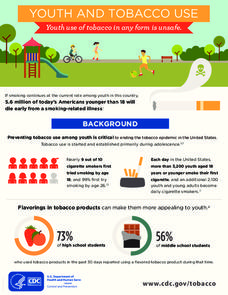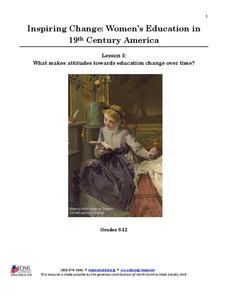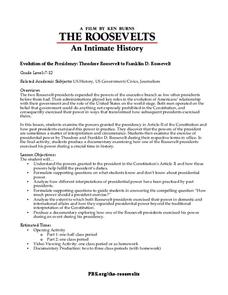NPR
Is There Really an Immigration Line?
If you've ever looked at the US immigration system, you know that it is complex and a source of controversy. An insightful lesson plan encourages learners to conduct their own analyses of the US immigration system by asking them to...
PBS
Racial Equality: How Far Have We Come and How Far Do We Have To Go?
Is everyone treated fairly in America? The culminating fifth lesson from a series of five has pupils explore racial inequalities from the 1960s and decide whether or not society has changed over time. The lesson comes with a speech from...
British Council
Smoking Stinks
There are lots of good reasons not to smoke. Make sure your middle and high schoolers understand each and every one with a lesson that prompts them to read anti-smoking posters, note the main points, and write a short response on the...
Centers for Disease Control and Prevention
Electronic Cigarettes: What's the Bottom Line?
A five-page infographic unveils the ins and outs of e-cigarettes. Numerous bullet points and pictures detail what e-cigarettes are, the ingredients found inside, and the health effects of using them.
Centers for Disease Control and Prevention
Statewide Smokefree Laws
Does your state allow smoking in public workplaces? What about in bars or restaurants? Take a look at an informative map of the United States to see what states do not allow smoking indoors, what states do not have indoor air laws on the...
Centers for Disease Control and Prevention
Equality in Smoking and Disease—Nobody Wins!
Fifty years ago, women were much less likely to die from smoking-related ailments than men. But thanks to targeted advertisements for and a wider availability of tobacco products, men and women are now equally susceptible to the health...
Centers for Disease Control and Prevention
Youth and Tobacco Use
There are a number of social, emotional, and physiological reasons why teenagers start smoking, and why they continue smoking into adulthood. Help class members understand why smoking begins in youth—and how to protect themselves from...
Centers for Disease Control and Prevention
Going SmokeFree Matters: Casinos
Everyone has the right to a smokefree workplace, but those who work in casinos are exposed to so much secondhand smoke that they can suffer the same ailments as heavy smokers themselves. Learn more about the effects of secondhand smoke,...
Centers for Disease Control and Prevention
Going SmokeFree Matters: Bars and Restaurants
Your students may not have ever had to decide between a smoking and nonsmoking area in a restaurant, but they still need to understand the health ramifications of secondhand smoke. A comprehensive infographic includes several facts about...
Centers for Disease Control and Prevention
Going SmokeFree Matters: Multiunit Housing
If you smoke cigarettes in an apartment or condominium complex, the secondhand smoke can travel through walls, ventilation systems, and plumbing to your neighbors' homes. Learn more about the ways smoking can affect those living in...
Centers for Disease Control and Prevention
Going SmokeFree Matters: In Your Home
Is secondhand smoke avoidable if you live with a smoker? Pupils look over an infographic to learn more about how secondhand smoke can travel throughout several rooms, who is more likely to be affected by smoke, and what health conditions...
Southern Poverty Law Center
Evaluating Online Sources
All sources are pretty much the same, right? If this is how your class views the sources they use for writing or research projects, present them with a media literacy lesson on smart source evaluation. Groups examine several articles,...
Prestwick House
Writing Arguments in Response to Nonfiction
Emotional appeal or argument? That is the question. An informative lesson helps your class recognize the difference between a logical argument and an emotional appeal and learn how to craft an argumentative response. Writers develop a...
NPR
The History of America’s Weed Laws
To understand the laws regarding marijuana use in the United States, you can go all the way back to the 1800's to learn about farming hemp, or you can go back to 2018 when California became the sixth state to legalize recreational...
NPR
Can You Beat Cognitive Bias?
In a time of fake news, media manipulation, and Internet trolls, a resource equips learners with the tools they need to recognize and combat resources that are designed to appeal to our cognitive biases. Introduce learners to five...
PBS
March on Washington: A Time for Change
Young historians conclude their study of the events that lead up to and the planning for the March on Washington. After examining videos and primary source documents, they consider the civil rights objectives that still need to be...
National Society Daughters of the American Revolution
Lesson 3: What Makes Attitudes Towards Education Change over Time?
The struggle for women's rights is not unique to this generation, or even to the 20th century. Class members explore the conflicting opinions of Alexander Graham Bell and his wife, Mabel Hubbard Bell, regarding women's pursuits of higher...
Daughters of the American Revolution
Lesson 2: How Do We Determine the Value of Education?
Have women always had the same educational opportunities as their male counterparts? Young historians read an 1819 essay by Emma Willard on the state of female education in the 19th century before discussing their views regarding women's...
Daughters of the American Revolution
Lesson 1: How Do Society’s Expectations Influence Education?
The history of women's education can be traced back to the delicate stitching of student samplers from the 19th century. Modern-day pupils examine and analyze four primary sources, three of which are images of embroidered samplers, which...
PBS
Evolution of the Presidency: Theodore Roosevelt to Franklin D. Roosevelt
How much power should a president be allowed to exert? Theodore Roosevelt and Franklin D. Roosevelt exercised their power according to their interpretations of the United States Constitution, and these interpretations affected the...
Stanford University
Voices of the Struggle: The Continual Struggle for Equality
As part of a study of the Civil Rights Movement from 1868 to the present, class members examine first person narratives, the Supreme Court case Brown v. Board of Education, and other significant events in civil rights history. They then...
J. Paul Getty Trust
Looking and Learning in the Art Museum — Lesson 3
Curator, artist, art handler, archivist, conservator-restorer, guide. Who would have thought there were so many different kinds of museum professionals? After a visit to an art museum, class members reflect on the role of the museum in...
J. Paul Getty Trust
Picturing a Story: Photo Essay about a Community, Event or Issue
Picture this. Class members follow in the footsteps of W. Eugene Smith, Dorothea Lange, James Nachtwey, and Lewis Hine by creating their own photo essay about a local event or issue.
US National Library of Medicine
Drug Use and Abuse: Past and Present
Pick your poison: tobacco, alcohol, opiates, cocaine, or marijuana. An online exhibition launches a research project that asks groups to select one of the five drugs and gather information on how the use of the drug and the regulations...

























